Looking for a fermented beet recipe? This fermented beet sauerkraut recipe uses a combination of raw beetroot, cabbage (white or red), apple, ginger and garlic. The versatile beetroot kraut can be tossed through salads and piled on top of your avocado toasts or even served along roast meats or fish.
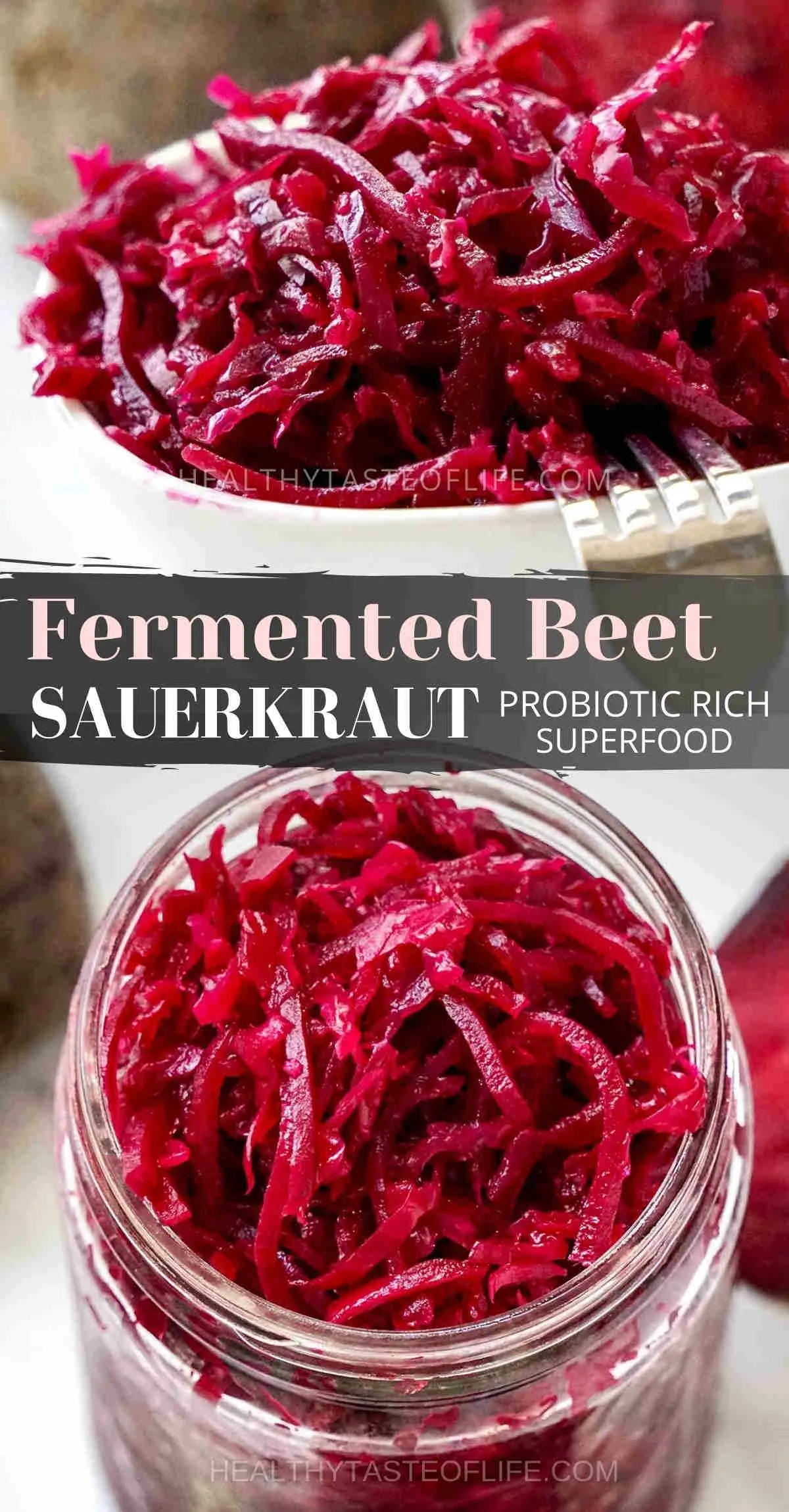
Fermented Beet And Cabbage Recipe
The earthiness and sweetness of beets is balanced and smoothed out by the crunchy, mild cabbage while the garlic and ginger gives it a kick and extra health benefits. And the apples provide just a hint of natural sweetness to the beetroot kraut.
I loved this crispy, crunchy, sour fermented beetroot and cabbage combination the first time I tried it! It reminded me of this red cabbage sauerkraut. But the taste has more earthiness and a deeper flavor.
I use beetroots a lot: for making beet salads, beet crackers, beet and sauerkraut soup, a healing beet smoothie or a detoxing beetroot juice. So this recipe was a must try for me.
If you love fermented veggies, also check out:
- Fermented Cauliflower
- Fermented shaved carrot salad recipe
- Fermented Cucumbers (Dill Pickles) No Vinegar
- Fermented Fresh Fish (Mackerel) Recipe
- Fermented Watermelon Recipe (Vs Pickling)
- Fermented Tomatoes Guide
Beet Sauerkraut Benefits
This beet sauerkraut is perfect for cold and flu season, delivering tremendous health benefits while body is fighting the bad germs. The fermentation process makes this beetroot kraut (as it contains garlic and ginger) a brilliant immune boosting, nutrient-dense, probiotic-rich super-food that helps to keep your gut flora (microbiome) well balanced.
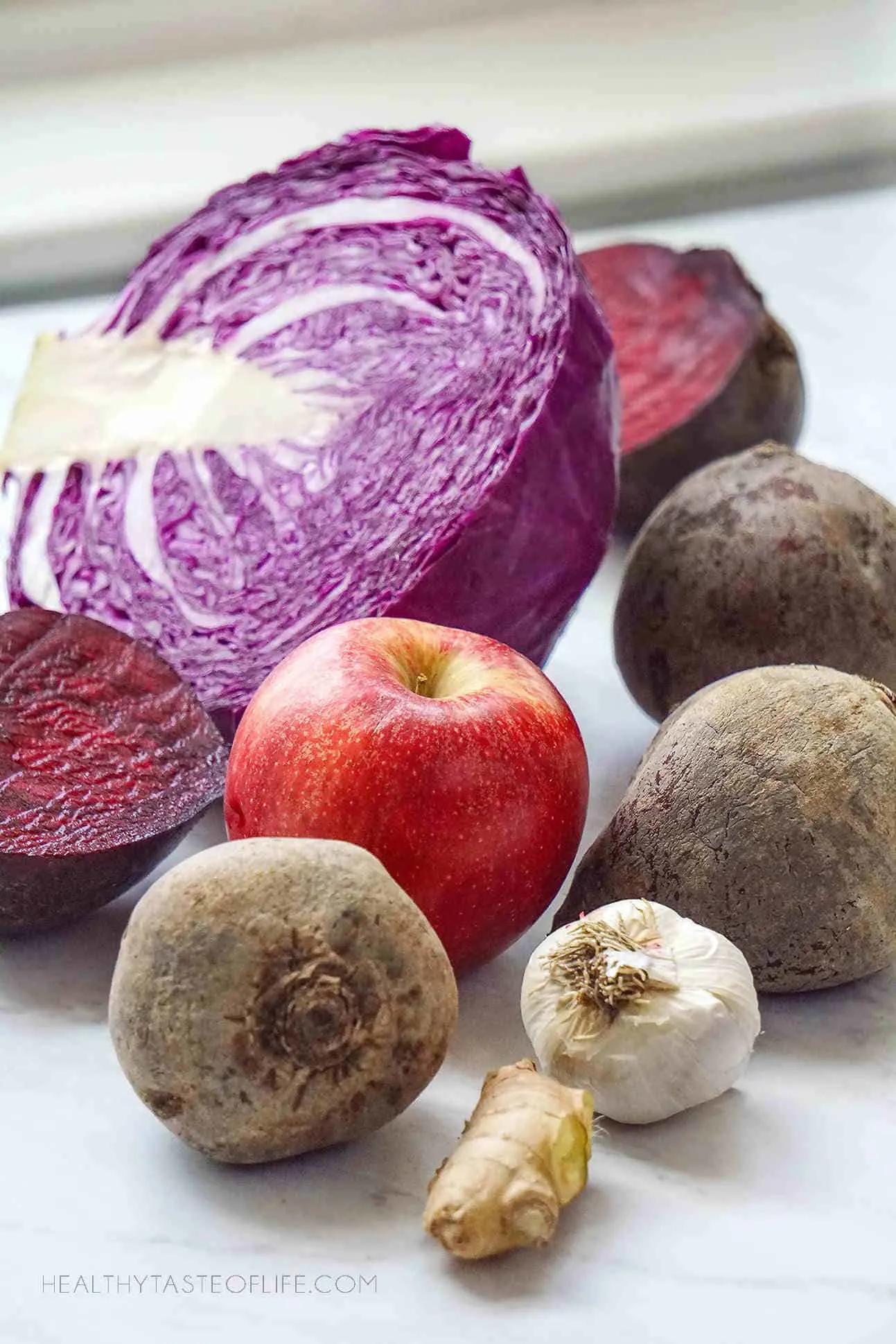
Related: Creamy Chickpea Salad With Red Sauerkraut
Beets are one of my favorite vegetables and their blood purifying, immune stimulation, detoxifying and anti-inflammatory properties made me want to take advantage of that!
But I couldn’t ferment beets on their own because the sweet root vegetables gives the bacteria way too much sugar to eat and you end up with a very active batch that doesn’t keep long. It will produce a thick slimy juice that goes bad easily. Believe me, I tried it!
The only option is to ferment the beets together with cabbage, which is low in sugar. A general rule of thumb for making beetroot sauerkraut, is to keep the ratio at 55-60% cabbage, and 35-40% beetroot, then the other 5% – spices or other additional flavoring.
Here I opted for garlic and ginger – the best antibacterial and anti-inflammatory agents known in nature!
Related: Red cabbage soup with sauerkraut
Fermented Beets Benefits
It is already well known that probiotic-rich fermented foods have a lot of health benefits help us fight inflammation, strengthen, heal and protect the gut lining and help us better absorb nutrients and minerals.
Related: Cancer Killer Juice: Pomegranate, Red Cabbage And Blueberry
Plus they are not only beneficial for the gut health, but are essential for our mental health as well (as the brain function is connected to the gut function).
- 1. Beets in particular are packed with anti-inflammatory phytonutrients, loaded with essential minerals like magnesium, potassium, copper, iron, plus they are a great source of Vitamins: A, B, and C, as well as healthy fiber. And fermenting the beets, facilitates the absorption of these vitamins and minerals into the body.

Related: Best Cabbage Juice Recipe For Ulcers
- 2. Long term beet fermentation (raw) also preserves these nutrients. The beneficial bacteria consume and break down (due to enzymes – not naturally present in the food before fermentation) the sugars and starches (naturally present in beets) into alcohols and acids. Thus acting like a natural preservative without using vinegar and sugar.
- 3. Lacto-fermented beets just like the raw beets, have very powerful antioxidant, anti-inflammatory and detoxifying properties, also they improve our intestinal flora and enzyme activity [3]. Therefore fermented beets are excellent for our digestive system especially for those who have an autoimmune condition.
Related: Simple Easy Cabbage and Carrot Salad
How To Make Red Cabbage And Beet Sauerkraut
All you need to ferment the beets and other ingredients is salt, a touch of water (maybe), and a system to keep everything submerged in.
Here are step by steps instructions for making beetroot kraut:
1. First work on shredding or slicing beets. Cut in whatever shape you desire. The chunkier the crunchier. Personally, I like smaller thinner pieces because it works well as a garnish. Plus by exposing as much surface area as possible helps pull out the juices. Everything must be the same thickness, so that everything ferments evenly.
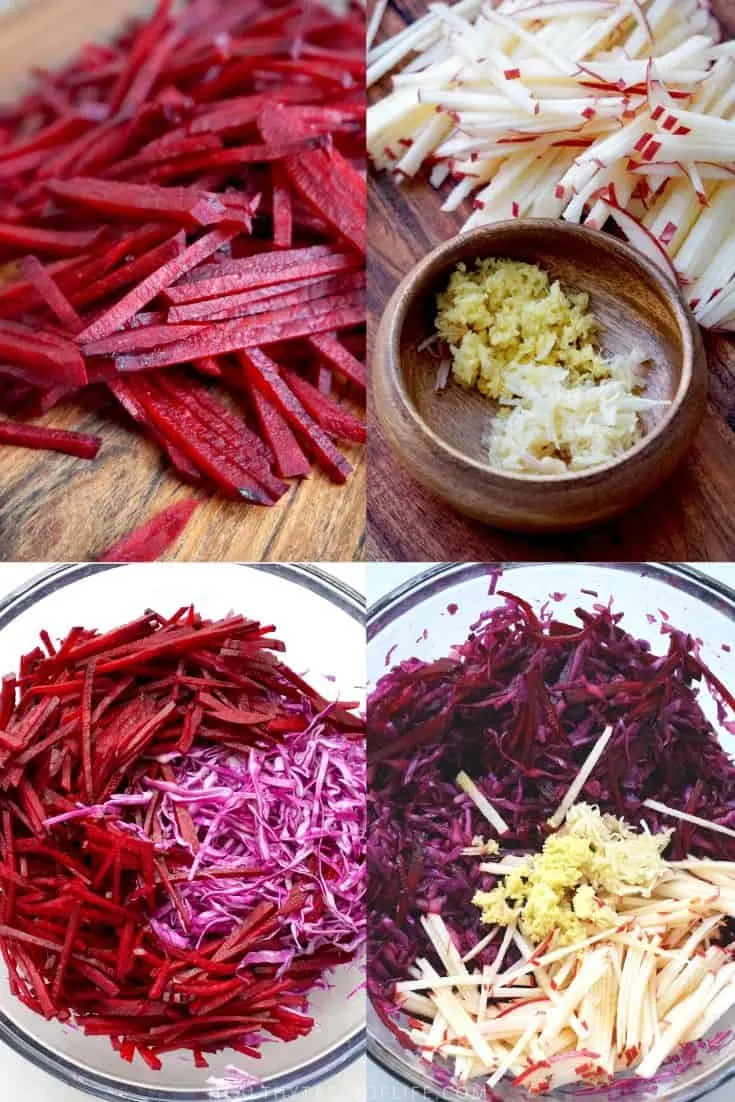
For this I’m using a mandoline to julienne the beets and apples and the slicer to thinly shred the cabbage. The ginger and garlic will be thinly grated also, the smaller the better.
- 2. Transfer the shredded red cabbage to a large bowl with plenty of space for you to get your hands in and mix it around. Leave your beets and apples to the side for now.
- 3. Add salt. You’ll want to use a really nice, coarse, unprocessed good quality salt, like this Celtic Sea Salt.
- 4. Massage the cabbage mixture with your hands until it breaks down and becomes soft (about 3 min) and then let it sit for 10 minutes to give it time to break down more and release more juices.
- 5. Add the julienned beets, give it another 2 minute massage, then mix in the apples, ginger and garlic until it is combined evenly.
- 6. Transfer into a container. Here you can use a fermentation kit but if you are willing to improvise like I do, just use a regular half gallon glass jar, and find weights (like a small heavy glass jar filled with water). Keeping the beet and cabbage kraut in an anaerobic environment (submerged in the liquid) during the fermentation period is the key to success.

7. Pack the everything tightly, pushing it all the way down until it submerges in its own juices. Leave about 1½ inches of space from the top of the jar. If there is not enough brine to cover the cabbage and beetroot sauerkraut, add more brine by combining a teaspoon of sea salt with 1 cup of water.
8. Cover the top of the jar with a small plate (or saucer) or a coffee filter secured with a rubber band, this will prevent contamination with other bacteria and will give the beetroot sauerkraut enough oxygen to keep fermenting.
9. Culture at room temperature (65-70°F is preferred) for 4-5 days before transferring it to the refrigerator. The longer it stays out the more sour it becomes, so this is a matter of personal taste. Once refrigerated, the beet and cabbage kraut will keep for up to a year.
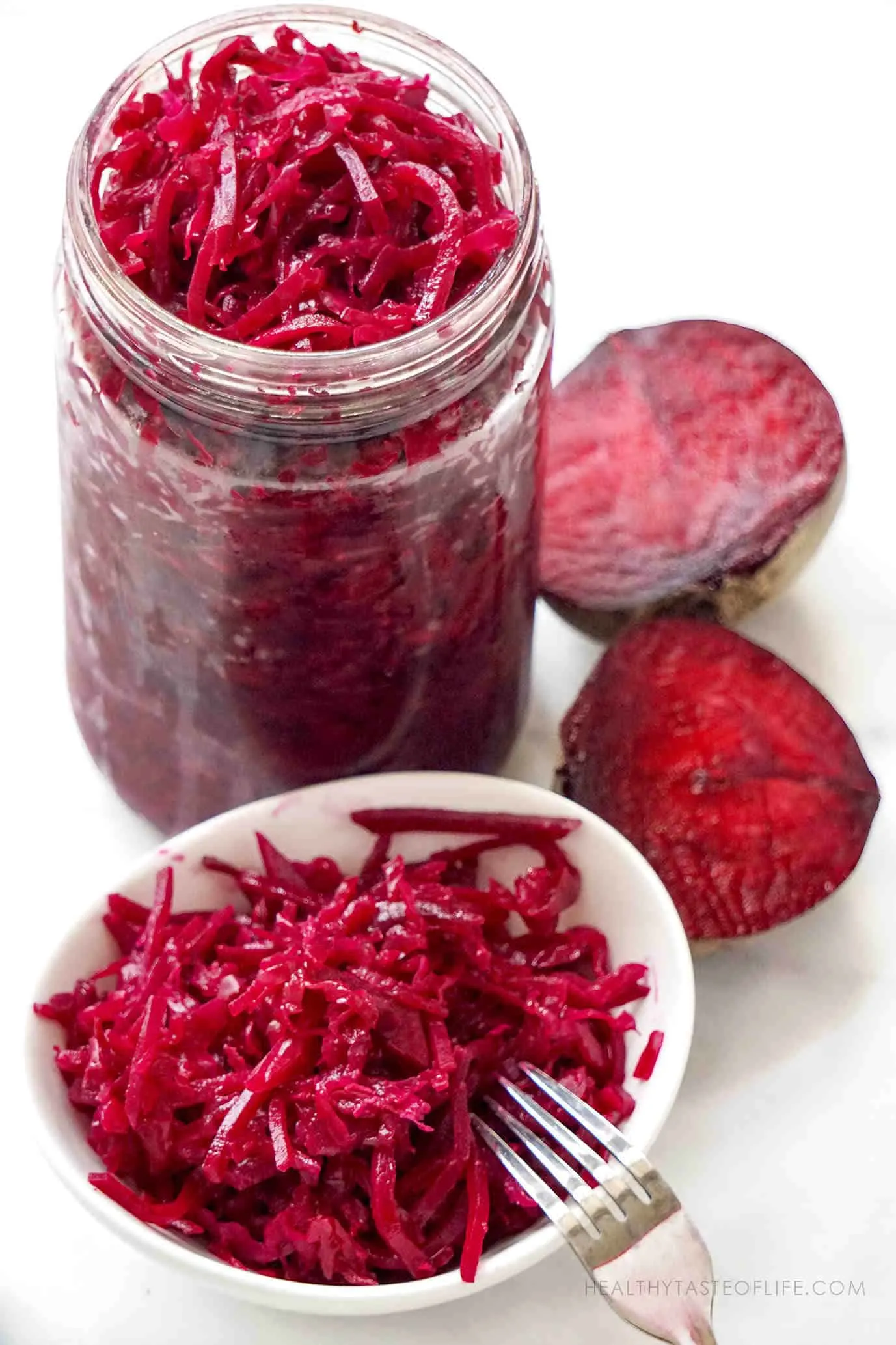
RELATED: Shrimp Cabbage Salad
Tips For Fermenting Beets And Cabbage
- The golden ratio for fermenting is 1.5 tsp of salt per lb (~500g) of vegetables. But I’m using a little bit less. When fermenting sweet vegetables like beets, the use of cabbage, which is in low sugar will give the best results. A general rule of thumb is to keep the ratio at 55-60% cabbage, and 35-40% beetroot, then the other 5% – spices or other additional flavoring.
- You don’t want to introduce any non-clean bacteria to your fermented beet sauerkraut, so make sure any utensils or fingers used are clean.
- When fermenting your red cabbage and beetroot sauerkraut, leave at room temperature for 3 days at minimum, or for up to three weeks maximum. The longer you leave your fermented beet and cabbage kraut, the more sour its flavor will become.
- During the first few days of fermentation: carbon dioxide will be produced. The jar might become very full with liquid that can seep out. That’s why I recommend not screwing a lid. Instead place a small saucer (or lid – loosely) on top, and a larger plate under the jar, to collect the overflowing liquid.
Serve The Beetroot Kraut With:
- Cabbage Fritters (Fried or Baked)
- Chicken Liver Patties
- Healthy Butternut Squash Casserole (Vegan)
- Savory Vegan Twice Baked Sweet Potatoes
- Potato Fritters With Crab Meat
- Quinoa Poke Bowl With Shrimp
- Gluten Free Swedish Meatballs
More Beetroot Recipes You Might Like
If you made this red cabbage and beetroot sauerkraut, then please leave a comment or a star rating below! Your feedback is really helpful for me and readers!
Fermented Beets + Cabbage (Probiotic Rich Beetroot Sauerkraut) Recipe
Ingredients
- 2 medium raw beets - (about 4 cups, julienned about 3.5 lb or 1600g)
- 1 small cabbage head - (about 5 cups, shredded – about 3.5 lb or 1600g)
- 1 inch ginger - peeled and thinly grated or minced
- 3 cloves garlic - peeled and thinly grated or minced
- 1 medium apple - any kind
- 2 tbsp Celtic sea salt
Instructions
Prepare The Veggies
- Wash the cabbage really well in cold running water, remove and discard any discolored outer leaves. Wash and peel the beets, ginger and garlic. No need to peel the apple.
- For this I’m using a mandoline to julienne the beets and apples, and thinly shred the cabbage. Or julienne with a chef’s knife. All separate. The ginger and garlic will be thinly grated also, the smaller the better.
Toss With Salt
- Transfer the shredded cabbage to a large bowl with plenty of space for you to get your hands in and mix it around. Leave your beets and apples to the side for now. Add salt. You’ll want to use a really nice, coarse, unprocessed good quality salt, like this Celtic Sea Salt.
- Massage the cabbage with your hands until it breaks down and becomes soft (about 3 min) and then let it sit for 10 minutes or so until the mixture has wilted a bit and released more salty juice (water). Add the julienned beets, give it another 2 minute massage then mix in the apples, ginger and garlic until it is combined evenly.
Place In Jars To Ferment
- Pack the mixture and juice into clean mason jars. Firmly pack down until the liquid comes up. Liquid should lightly cover the mixture. And leave at least 1-2 inches space at the top for expansion.
- If there is not enough liquid to cover the cabbage, mix 1 tsp salt with 1-1.5 cups of water, and add until the water level is enough to cover the mixture. Use 1 or 2 cabbage leaves over the top to keep it from floating up. Place a clean glass weight over the leaves and press down so everything is submerged under the liquid.
- Cover loosely with a lid and place on a plate to catch any overflowing liquid. Place on your kitchen counter in a shaded place for 3-5 days. The number of days for fermenting will depend on the room temperature.The next day tiny bubbles should rise to the top, indicating it started to ferment. If scum appears, remove it with a spoon.
- After 5 days place it in the fridge to slow down the fermentation process. The longer it ferments, the better it will taste! In about 10 days you can start eating.
Notes
Tips For Making Beetroot Sauerkraut
- Use a glove, if you don’t want to stain your hand with red beet juice. Although even if they become stained with beetroot, rub with lemon juice and salt before washing with soap and water and you are all set.
- You can use a small 4-ounce canning glass jar as a weight to hold the fermenting beets below the brine.
- The addition of garlic will make the smell slightly off putting the first few days of fermentation, but once it’s refrigerated, its not even noticeable.
- The golden ratio for fermenting is 1.5 tsp of salt per lb (~500g) of vegetables. But I’m using a little bit less.
- When fermenting your beetroot kraut, leave at room temperature for 3 days at minimum, or for up to three weeks maximum. The longer you leave your beet sauerkraut, the more sour its flavor will become.
- During the first few days of fermentation: carbon dioxide will be produced. The jar might become very full with liquid that can seep out. That’s why I recommend not screwing a lid. Instead place a small saucer (or lid – loosely) on top, and a larger plate under the jar, to collect the overflowing liquid.
- Anything that is exposed to air while fermenting, may get moldy, so make sure you check daily and push back in the liquid if anything escaped.
Nutrition
The information shown is an estimate provided by an online nutrition calculator.
©HealthyTasteOfLife. Content and photographs are copyright protected and need prior permission to use. Copying and/or pasting full recipes to other websites and any social media is strictly prohibited. Sharing and using the link of this recipe is both encouraged and appreciated!

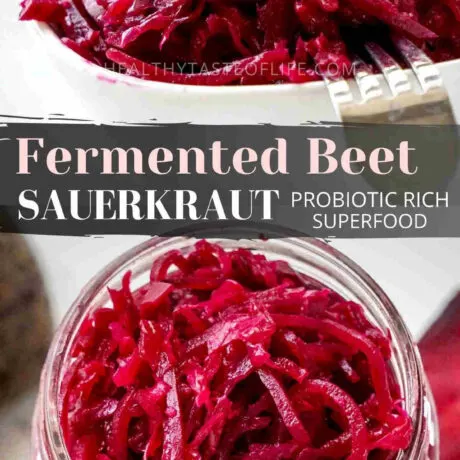

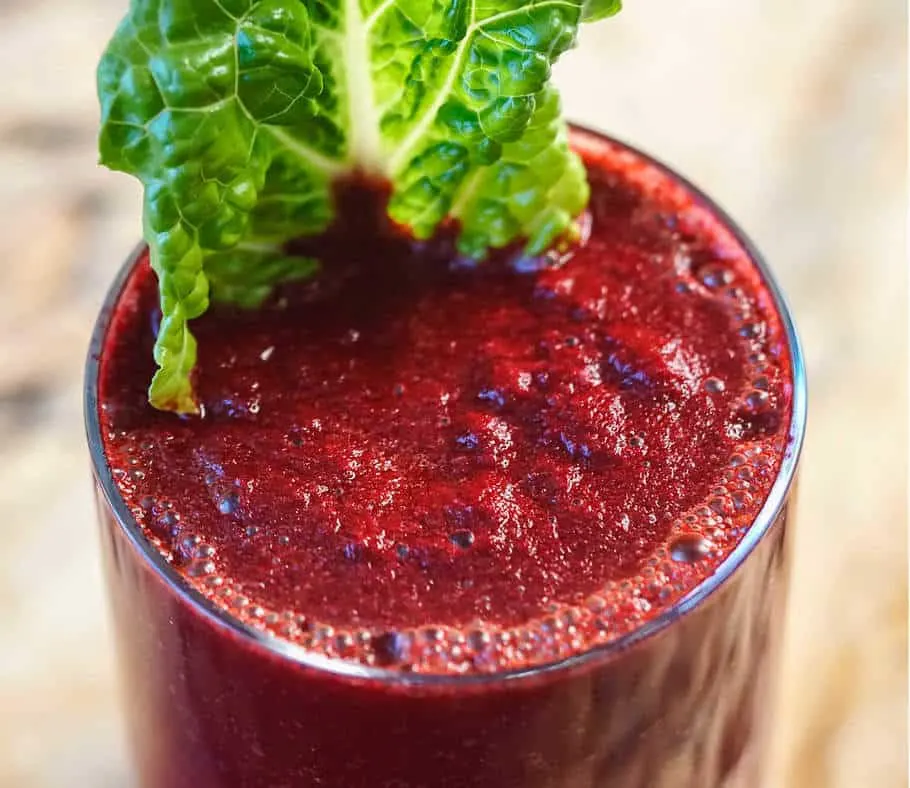


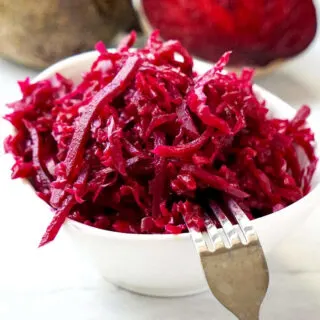
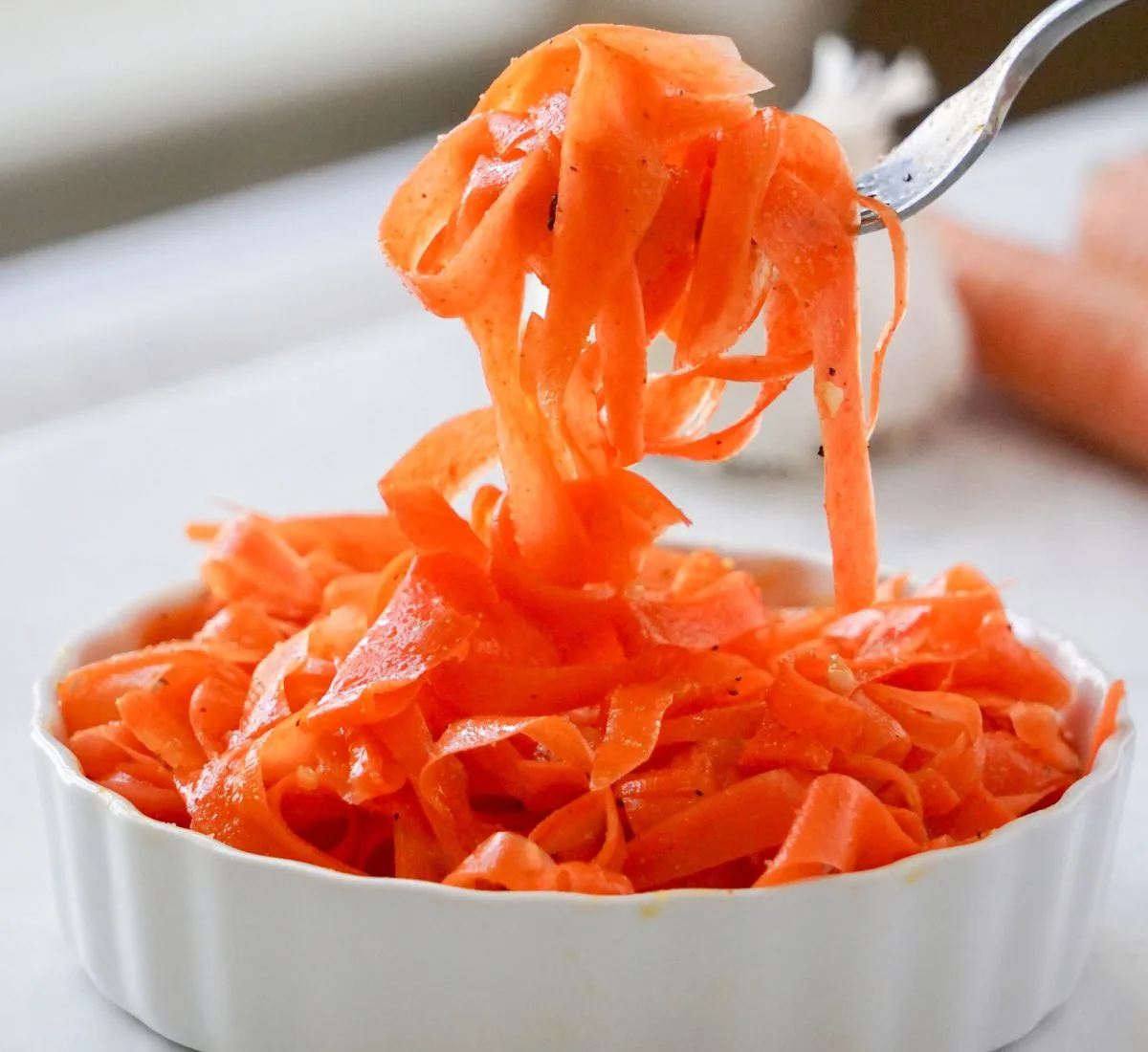

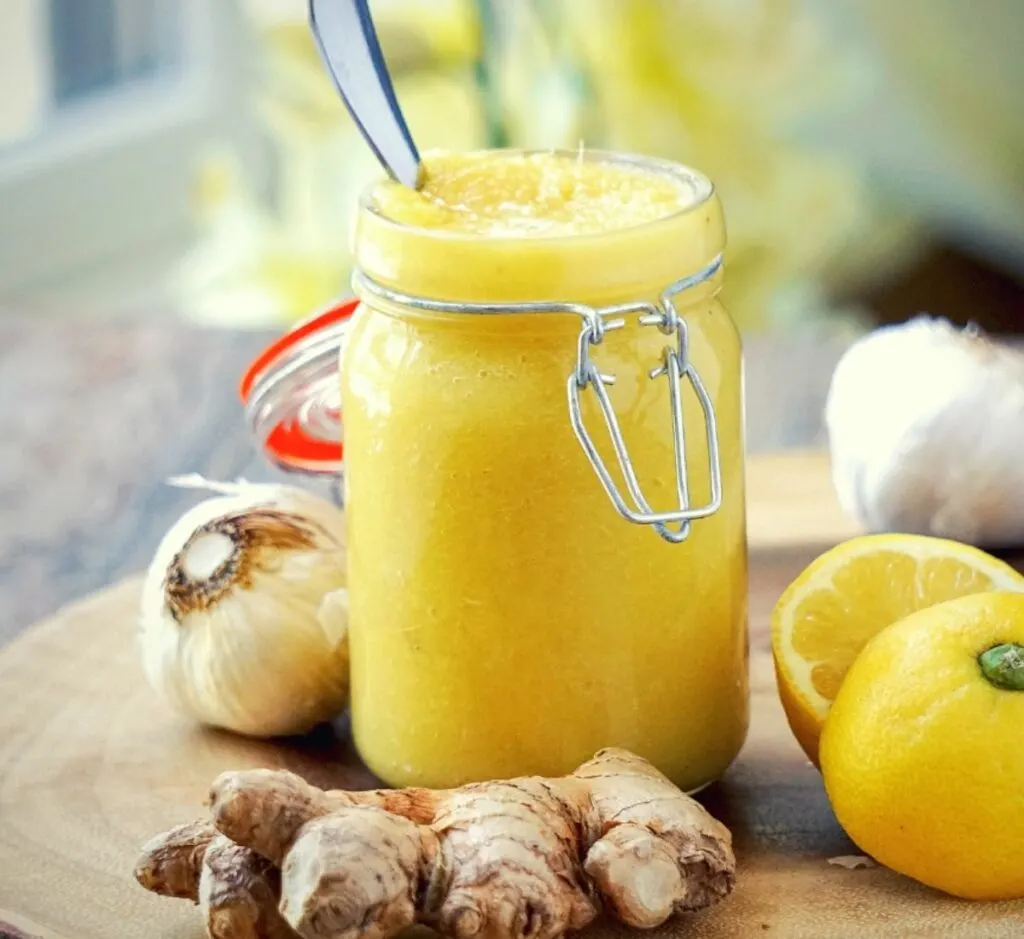

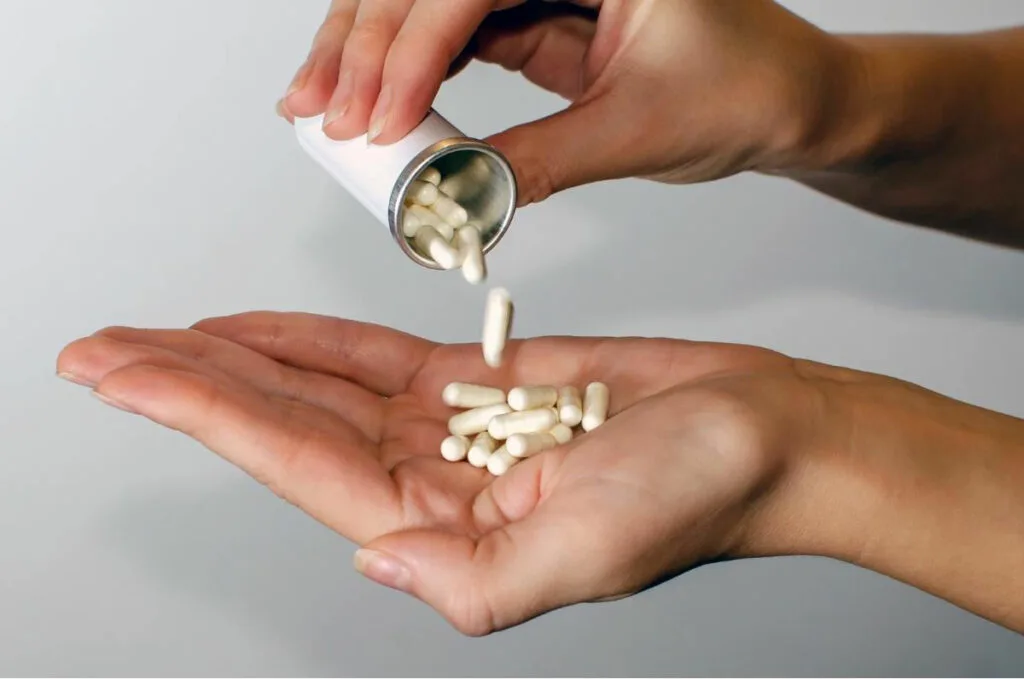



Diana
Tuesday 8th of November 2022
I’m going to try this recipe this evening. Pretty excited about this new fermenting adventure. I was wondering if I’d ruin your recipe by adding carrots?? What are your thoughts? Thanks so much for sharing!
HealthyTasteOfLife
Wednesday 9th of November 2022
I hope you try it, and sure, you can add 2-3 carrots it will not hurt, just follow the instructions on salt to veggie weight ratio.
Malcolm
Sunday 30th of October 2022
Been fermenting for a week now outside the fridge. Probably going for atleast one more week to get that sour flavour I love. Thanks for the recipie!
HealthyTasteOfLife
Thursday 3rd of November 2022
If you preffer it more sour then yes that might be a good idea! My pleasure!
Ruby
Tuesday 25th of October 2022
Once it is fermented, can I can the kraut in a hot water bath or will that destroy the probiotics?
HealthyTasteOfLife
Friday 28th of October 2022
Yes, heat (hot) will destroy the beneficial bacteria.
Victoria Sweeney
Friday 18th of March 2022
I've made this a number of times. I use the ratio of ingredients sort of closely but ferment it quite differently. This is my favorite off all recipes I found online.
HealthyTasteOfLife
Tuesday 22nd of March 2022
That's wonderful, thank you for your feed back Victoria!
Olive
Tuesday 5th of May 2020
Wow I didnt know fermented beets and cabbage can look so appetizing. I tried to ferment beets by themselves once and they didn't turn out right. When I saw your post I decided to mix cabbage in as well, and wow , what a difference! Absolutely delicious. I use it in my salad, my tacos and even on the side!
HealthyTasteOfLife
Tuesday 5th of May 2020
I couldn't ferment beets on their own either, I ended up with a thick slimy batch that smelled good but the taste wasn't right. I'm really glad you gave this recipe a chance!